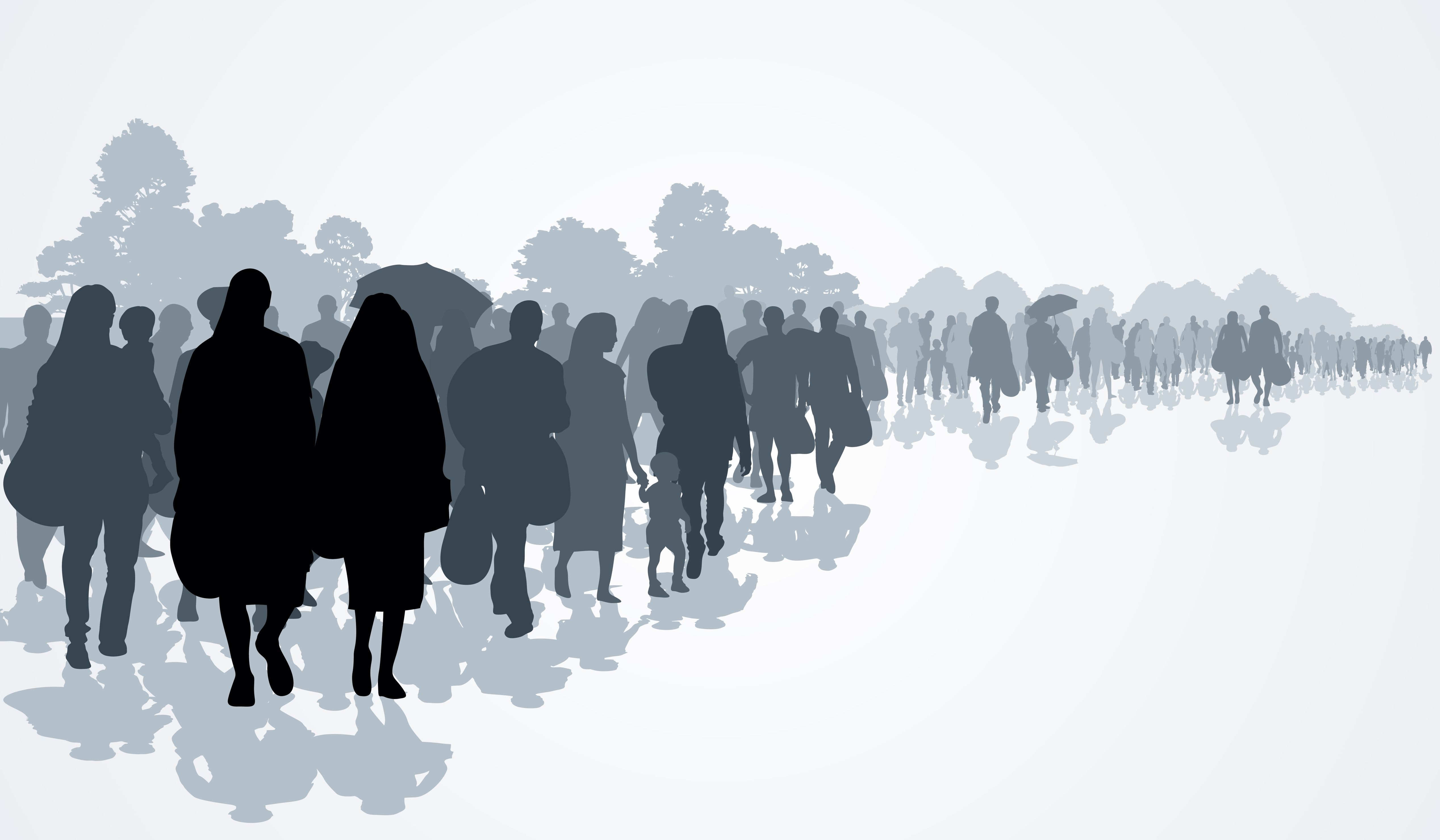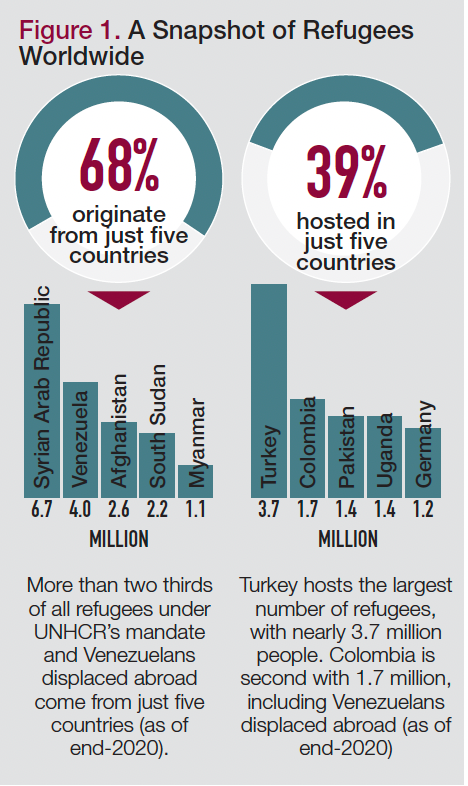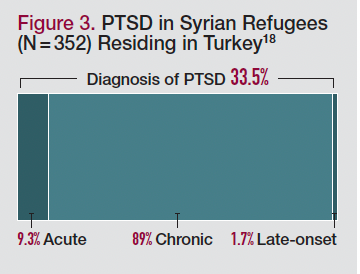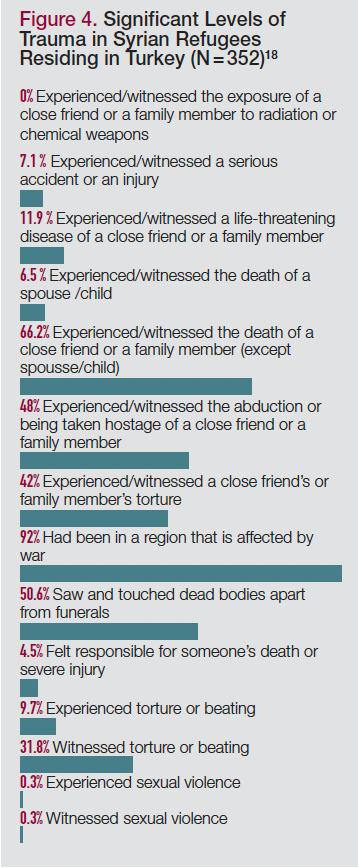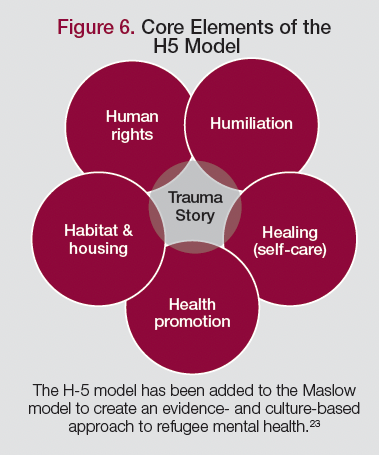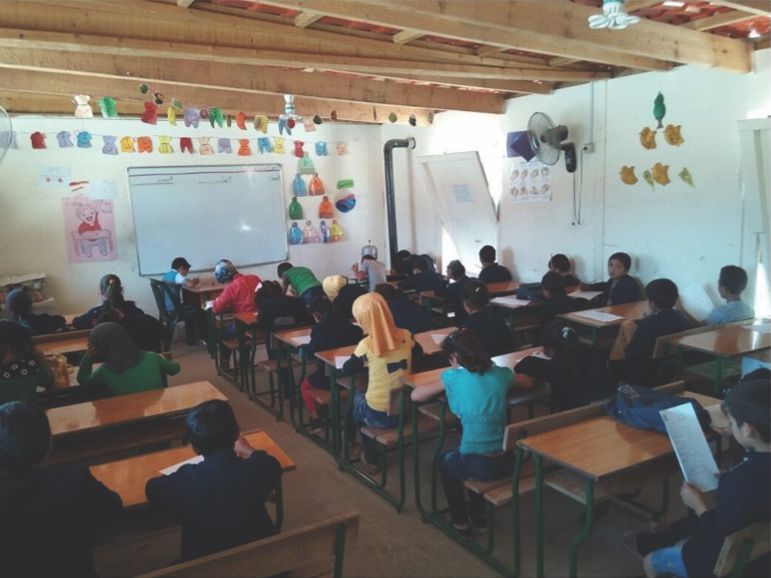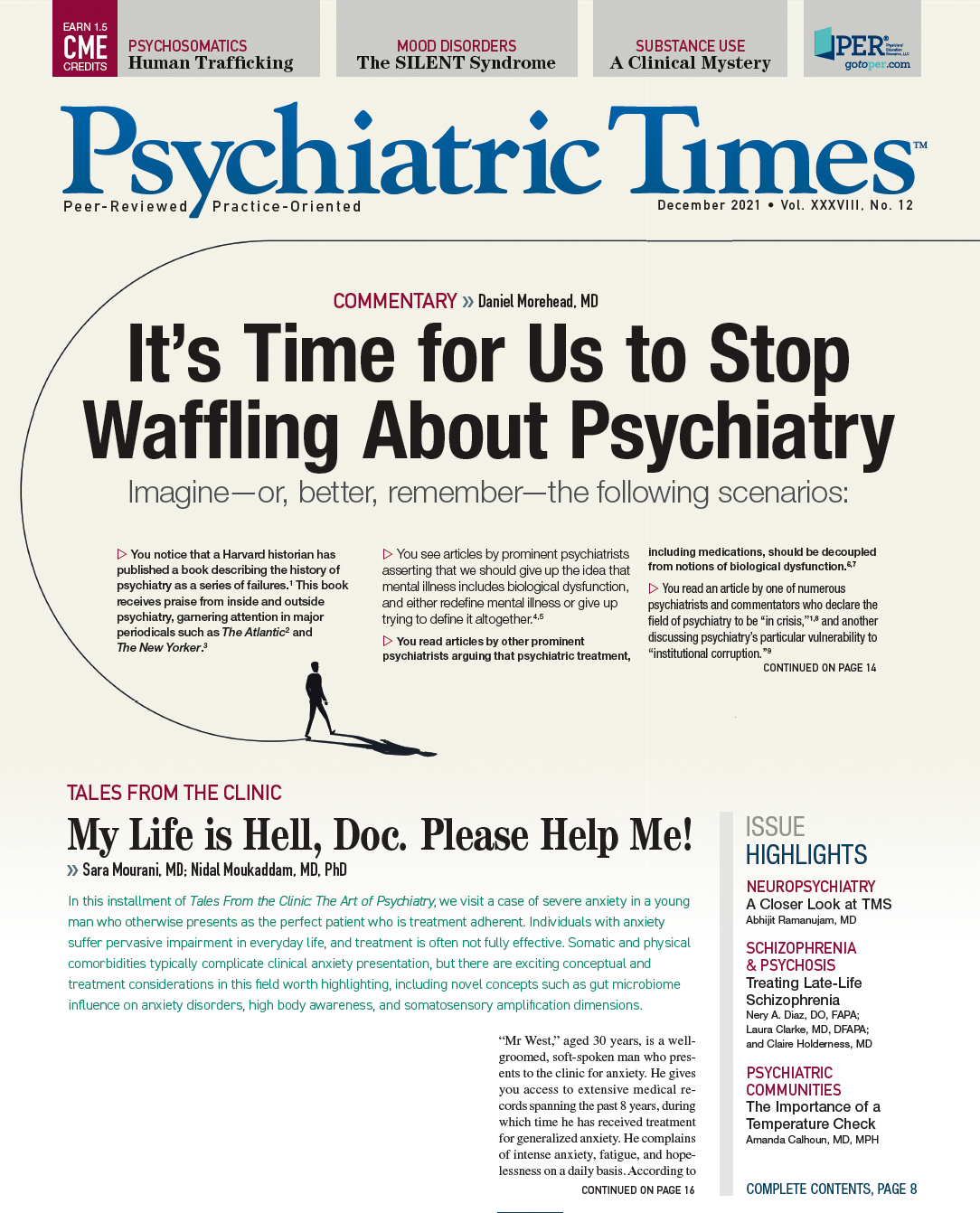SPECIAL REPORT: GLOBAL PSYCHIATRY
The world is facing global crises of catastrophic magnitude. Paradoxically, while modern psychiatry is entering a golden age, with many scientific and cultural advances leading to effective low-cost care for common illnesses such as anxiety and depression, and less stigma associated with mental health disorders, the global catastrophes facing every person have led to a collective trauma. Healers and sufferers are now universally affected—no one is safe—creating a new solidarity of mutually concerned interests that, if mobilized, could lead to the establishment of new and powerful co-constructed relationships and actions. Old ideas need to be discarded, and new solutions imagined, studied, and implemented. The world is at a crossroads, and the psychiatric profession can be at the vanguard of offering a new vision. In this brief review of one of the major global crises facing humanity—the refugee crisis—a new vision of psychiatric care is considered. This vision, presented to the National Academy of Medicine in 2016, has since matured, as we have been forced to confront major crises facing all of us.
Also In This Special Report
These historical crises, which include climate change and “ecocide,” the COVID-19 pandemic, and refugee displacement due to conflict or environmental degradation, feel like a slow-moving train wreck that is impacting our collective sense of health and well-being. The impact on the younger generations is especially concerning. Psychiatry can play a major role in addressing public anxiety and fear related to the “enormity problem.” ABC News correspondent Bill Blakemore—who has reported on war, conflict, and climate change over the course of 4 decades—uses this term to describe problems so big that solutions are impossible to comprehend.1 The enormity problem leads to feelings of hopelessness and despair; a future horizon does not exist. This sense of enormity may lead us to become metaphorically unconscious when considering what—if anything—can be done to alleviate these problems. Mental health practitioners are faced with the following realities:
Ecocide
According to the United Nations Environment Programme, the Earth is in the midst of a mass extinction of life, with 100 to 200 species of plants, insects, birds, and mammals becoming extinct every day. This loss is considered to be the largest extinction of life since the that of the dinosaurs 65 million years ago. Environmental degradation linked to climate change has a major impact on displacement, poverty, and sustainable development.2
Climate Change
The Intergovernmental Panel on Climate Change: 6th Assessment Report,3 written by 234 authors from 66 countries reviewing 14,000 scientific papers, found that:
• Humans are unequivocally responsible for climate change.
• Some climate system changes are irreversible.
• Although time is running out, it is not too late to make a difference.
The planet is already 1.1 °C warmer than in the preindustrial period, and it will be 1.5 °C warmer by 2040. Carbon dioxide is at its highest level in the past 2 million years; sea levels are rising faster than in the past 3000 years; and ice is at its lowest in 1000 years. The world will continue to experience catastrophic storms, droughts, wildfires, and rising sea levels. The United Nations (UN) estimates that more than 70 million persons have already left their homes due to extreme weather events. It is believed that 1 billion persons will be displaced because of climate change by 2040.4 The absolute number of persons living in informal settlements or shantytowns is already more than 1 billion.5 These environments are characterized by air pollution, poor waste disposal, and lack of public green spaces and health services, especially mental health services. The UN has recognized that climate change, environmental degradation, and natural disasters are interacting to create historic increases in levels of mass migration. Filippo Grandi, UN High Commissioner for Refugees (UNHCR), noted4:
We need to invest now in preparedness to mitigate future protection needs and prevent further climate-caused displacement. Waiting for disaster to strike is not an option.
COVID-19 Pandemic
The COVID-19 pandemic has impacted the world in a way not seen in more than a century. There are more than 230 million confirmed cases in 221 countries and territories and 4.8 million deaths at the time of this writing. The United States has sustained more than 44 million cases and more than 700,000 deaths.6 The pandemic has been exacerbated by racial trauma, bringing the health disparities in communities of color to the forefront.7 The pandemic has negatively affected the mental health of people worldwide, with an extreme impact on refugees and displaced persons.8 In many countries such as India, Iran, Nepal, and Afghanistan, it has led to displacement of tens of thousands of people.9
Simultaneously, the mental health impact on the world’s health care practitioners has been dramatic.2,10 Psychiatry has been stepping up to meet the growing demands for COVID-19-related mental health services. For instance, at my institutions (Massachusetts General Hospital and Harvard University), caring for those who have cared for others is a top priority.
Tackling the Refugee Crisis
According to UNHCR, there are now 82.4 million displaced persons worldwide, including 35 million children (Figure 1). This number includes 48 million internally displaced people, 26.4 million refugees, 4.1 million asylum seekers, and 3.9 million Venezuelans displaced abroad.11 This represents the largest number of persons on the move since World War II. The rapid destruction of the natural world, climate change, and the COVID-19 pandemic are dramatically impacting the number of persons forced to leave their homes.
The Harvard Program in Refugee Trauma (HPRT) has been clinically caring for refugee survivors of mass violence and torture for more than 4 decades,12 caring for the health and mental health needs of more than 10,000 refugee patients in the United States and highly traumatized populations in Cambodia, Peru, Bosnia-Herzegovina, Croatia, Japan, Liberia, Lebanon, Italy, and Australia. Lessons learned over the past decades can help the fields of medicine and psychiatry to move beyond the enormity problem and serve as a model for the public health contribution to addressing the other global crises presented in this article. When HPRT established one of the first refugee clinics in the United States in 1981, little was known of refugee trauma and its impact on individuals, families, and communities. Refugee mental health was not considered important by international agencies responsible for the care of refugees. It was firmly believed that the refugee was like a rubber band, stretched by displacement: once returned home or resettled, the refugee would snap back to normal.13
In contrast, today refugee mental health is considered a priority by UNHCR and the World Health Organization (WHO). In my National Academy of Medicine presentation (before the COVID-19 pandemic), several major themes were addressed. The WHO definition of health—“a state of complete physical, mental, and social well-being and not merely the absence of disease or infirmity”—was expanded using the women’s health approach by Chetna (www.chetnaindia.org) to a more integrated holistic concept focusing on the creation of health that emphasized a healthy body, healthy mind, and healthy spirit for all people. Respect for personal and community agency, freedom from prejudice and stigma, and social justice were emphasized (Figure 2).
This new definition places importance on eliminating structural violence and social injustice, expanding access to schooling for children and education for women, and ending gender-based violence. The climate change crisis further highlights the need for environmental justice, including the right to access clean water, fresh air, and green spaces. Major efforts to stop the poaching and industrial harvesting of wildlife and native plants need to be added. This question must be answered: Can a human being be healthy in an environmentally degraded environment?
Tremendous advances have been made in scientifically and culturally validating the mental health impact of refugee trauma.13 Since the earliest population-based studies, the high prevalence of posttraumatic stress disorder (PTSD) and depression in refugee and war-surviving civilians has been consistently demonstrated.14 In a meta-analysis of epidemiologic studies, researchers showed that countries with a recent war history (1989-2018) yielded point-prevalence rates of PTSD of 26.51% and of major depression of 23.31%; of those who presented with PTSD, 55.26% presented with comorbid major depression.15 Similarly, these researchers estimated that 1.45 billion individuals worldwide experienced war between 1989 and 2018, and 354 million adult war survivors suffer from PTSD and/or major depression, and 117 million from comorbid PTSD and depression.16 A meta-analysis of sub-Saharan Africa revealed point-prevalence rates of PTSD of 25%.17 A recent study of Syrian refugees residing in Turkey illustrated the trauma they have suffered as well as their levels of prevalent PTSD18 (Figures 3 and 4).
The scientific evidence and culture-based approach to refugee mental health has expanded since the original work of Abraham Maslow, PhD.19 Maslow’s “Hierarchy of Needs” remains the foundation of the psychosocial care of refugees and other traumatized communities. It is organized in a 5-layered pyramid (Figure 5).
Maslow considered these goal-directed needs to be linear, starting at the base, with the most pressing and basic human needs lying at the lower end of the pyramid. At the top of the pyramid is the achievement of self-actualization. Maslow summarized this concept in his famous phrase, “What a man can be, he must be.” Maslow’s model has been criticized since the linear advance up the pyramid has proven not to be valid: Self-actualization occurs at every level of the pyramid, and the high need levels have been hard to define.20,21
Maslow’s model does not find a place for the clinical care of individuals who are highly traumatized and have severe mental health problems. A revised model based upon the human subjective experience of violence was therefore needed.22 HPRT added the clinical insights of the new H-5 model to the Maslow model to create an evidence- and culture-based approach to restore individuals to health and well-being.23 According to this model, the goal of humanitarian aid is to restore all individuals from traumatized status to wellness. The H-5 model includes 5 overlapping areas (Figure 6), at the core of which is the “trauma story.” All 5 dimensions are anchored in a common thread of the trauma story, ie, the personal life story and narrative of the survivor of human violence. Listening empathically is a key component of healing. The following is a brief synopsis of each area.
H1—human rights violations. All refugees have suffered human rights violations. These violations include gender-based violence and other unspeakable atrocities. Acknowledging and responding to human rights violations, including the pursuit of justice, are essential to the healing process.
H2—humiliation. In most refugee situations, humiliation is the primary goal of violence. Acts are used to create humiliation aimed at the physical, psychological, and cultural annihilation of the refugee community and society.
H3—self-healing. Self-healing is a natural process. In many refugee studies, altruism, work (for children, education), and spirituality are associated with increases in resiliency to violence.
H4—health promotion. Extensive research has revealed the long-term impact of violence on health and mental health of the patient who has been traumatized, including chronic disease, diabetes, stroke, drug addiction, suicide, and chronic depression. Health promotion needs to be implemented early in the refugee experience.
H5—habitat. The term habitat encompasses the total environmental and cultural context of refugees and other traumatized persons, as distinct from the more limited concept of housing or shelter. The term derives from the Latin habitare, which refers to the natural environment of a person or the place where an organism dwells. Habitat, which is also described by the term built environment, is especially important for refugees because they often face terrible living conditions for years after they have fled their homes, leading to social disruption, emotional damage, and psychological stress.
Healing environments can be created for refugees and displaced individuals.24 Figure 7 illustrates the built environments created by the gifted architect Rabih Shibli, MA, and his team at the American University of Beirut in Lebanon for Syrian refugee children.22 These schools were built by the children themselves using inexpensive recyclable material, which can be transported upon repatriation and are cheaper than UN tents. The architects incorporated plants to create a beautiful environment. HPRT’s research showed significant improvement in school attendance at these schools compared with that at UNHCR tent schools (HPRT unpublished manuscript).
The WHO added the Mental Health Gap Action Programme (mhGAP)25 in 2008 for the diagnosis and treatment of psychiatric and substance use disorders in low- and middle-income countries, which was expanded to include humanitarian emergencies.26 Faragh et al have clarified how the mhGAP can be made culturally sensitive, valid, and effective in varying cultural settings.27
Summary
As can be seen, enormous advances in the cultural and scientific mental health care of refugees and displaced individuals have been made over the past 40 years. The impact and potential treatment of the social determinants of health/mental health in refugees—including gender-based violence, poverty, injustice, and human rights violations—have been identified. Now the global crises of ecocide/climate change and the COVID-19 pandemic that are fueling global displacement and great human suffering need to be addressed upstream by psychiatry.
The silos that exist between the current systems of health care, economic development, and humanitarian assistance need to be dismantled and the systems integrated. Mental health professionals, including psychiatrists, and their medical-psychiatric science must be integrated into each of these domains. Each development project needs to be linked to systems of health and mental health care. For example, all persons (not just refugees) need access to primary health care that includes integrated mental health care.
Major global catastrophic crises are with us. But we can overcome our feelings of hopelessness and despair in the face of the enormity problem by working to restore to wellness those who have been damaged physically, mentally, and spiritually, and by advocating for public health solutions that can mitigate and prevent the root causes of the mental health crises facing the world today.
Dr Mollica is the Director of the Harvard Program in Refugee Trauma and a Professor of Psychiatry at Harvard Medical School.
References
1. Mollica RF, Fernando DB, Augusterfer EF. Beyond burnout: responding to the COVID-19 pandemic challenges to self-care. Curr Psychiatry Rep. 2021;23(4):21. Published correction appears in Curr Psychiatry Rep. 2021 May 27;23(7):43.
2. Brondizio ES, Settele J, Díaz S, Ngo HTeds. Global assessment report on biodiversity and ecosystem services of the Intergovernmental Science-Policy Platform on Biodiversity and Ecosystem Services; 2019.
3. IPCC. Climate Change 2021: The Physical Science Basis. Contribution of Working Group I to the Sixth Assessment Report of the Intergovernmental Panel on Climate Change. Cambridge University Press. In Press; 2021.
4. United Nations High Commissioner for Refugees. Climate change and disaster displacement. UNHCR. Accessed October 9, 2021. https://www.unhcr.org/en-us/climate-change-and-disasters.html
5. United Nations Statistics Division. Rapid urbanization and population growth are outpacing the construction of adequate and affordable housing. UNSD. Accessed October 9, 2021. https://unstats.un.org/sdgs/report/2019/goal-11/
6. COVID live update: 241,431,000 cases and 4,913,394 deaths from the Coronavirus - worldometer. Worldometers.info. Accessed October 17, 2021. https://www.worldometers.info/coronavirus/
7. Shiels MS, Haque AT, Haozous EA, et al. Racial and ethnic disparities in excess deaths during the COVID-19 pandemic, March to December 2020. Ann Intern Med. 2021;M21-2134. Published online October 5, 2021.
8. Rees S, Fisher J. COVID-19 and the mental health of people from refugee backgrounds. Int J Health Serv. 2020;50(4):415-417.
9. Balakrishnan VS. Impact of COVID-19 on migrants and refugees. Lancet Infect Dis. 2021;21(8):1076-1077.
10. The Physicians Foundation. 2021 survey of America’s physicians COVID-19 impact edition: a year later. The Physicians Foundation. Published August 4, 2021. Accessed October 16, 2021. https://physiciansfoundation.org/physician-and-patient-surveys/the-physicians-foundation-2021-physician-survey/
11. United Nations High Commissioner for Refugees. Refugee Statistics. UNHCR. Accessed October 7, 2021. https://www.unhcr.org/refugee-statistics/
12. Mollica RF. Healing Invisible Wounds: Paths to Hope and Recovery in a Violent World. Vanderbilt University Press; 2006.
13. Mollica RF. Waging a new kind of war. Invisible wounds. Sci Am. 2000;282(6):54-57.
14. Mollica RF, Brooks R, Tor S, Lopes-Cardozo B, Silove D. The enduring mental health impact of mass violence: a community comparison study of Cambodian civilians living in Cambodia and Thailand. Int J Soc Psychiatry. 2014;60(1):6-20.
15. Hoppen TH, Morina N. The prevalence of PTSD and major depression in the global population of adult war survivors: a meta-analytically informed estimate in absolute numbers. Eur J Psychotraumatol. 2019;10(1):1578637. Published 2019 Feb 22.
16. Hoppen TH, Priebe S, Vetter I, Morina N. Global burden of post-traumatic stress disorder and major depression in countries affected by war between 1989 and 2019: a systematic review and meta-analysis. BMJ Glob Health. 2021;6(7):e006303.
17. Ng LC, Stevenson A, Kalapurakkel SS, et al. National and regional prevalence of posttraumatic stress disorder in sub-Saharan Africa: a systematic review and meta-analysis. PLoS Med. 2020;17(5):e1003090. Published correction appears in PLoS Med. 2020;17(7):e1003312.
18. Alpak G, Unal A, Bulbul F, et al. Post-traumatic stress disorder among Syrian refugees in Turkey: a cross-sectional study. Int J Psychiatry Clin Pract. 2015;19(1):45-50.
19. Maslow AH. The Farther Reaches of Human Nature. Viking Press; 1971.
20. Geller L. The failure of self-actualization theory: a critique of Carl Rogers and Abraham Maslow. J Humanist Psychol. 1982;22(2):56-73.
21. Neher A. Maslow’s theory of motivation: a critique. J Humanist Psychol. 1991;31(3):89-112.
22. Mollica RF, Augusterfer EF, Campanile N. Culturally adapted therapeutic approaches: the healing environment and restorative therapy model. In: Aten JD, Hwang J, eds. Refugee Mental Health. American Psychological Association; 2021:137-166.
23. Mollica RF, Brooks RT, Ekblad S, McDonald L. The new H5 model of refugee trauma and recovery. In: Lindert J, Levav I, eds. Violence and Mental Health. Springer; 2015:341-378.
24. Huisman ERCM, Morales E, van Hoof J, Kort HSM. Healing environment: A review of the impact of physical environmental factors on users. Build Environ. 2012;58:70-80.
25. Keynejad RC, Dua T, Barbui C, Thornicroft G. WHO Mental Health Gap Action Programme (mhGAP) Intervention Guide: a systematic review of evidence from low and middle-income countries. Evid Based Ment Health. 2018;21(1):30-34.
26. World Health Organization. MhGAP Humanitarian Intervention Guide (MhGAP-HIG): Clinical Management of Mental Neurological and Substance Use Conditions in Humanitarian Emergencies. World Health Organization; 2015.
27. Faregh N, Lencucha R, Ventevogel P, Dubale BW, Kirmayer LJ. Considering culture, context and community in mhGAP implementation and training: challenges and recommendations from the field. Int J Ment Health Syst. 2019;13(1):58. ❒

